Management Principles in Australian Pharmaceutical Industry
VerifiedAdded on 2022/11/13
|14
|3576
|102
AI Summary
This report discusses the major challenges faced by firms in the Australian pharmaceutical industry and analyzes the business strategies of Amcal, Priceline, and Chemist Warehouse. It recommends new product development and identifies Chemist Warehouse as the most profitable company by 2022.
Contribute Materials
Your contribution can guide someone’s learning journey. Share your
documents today.
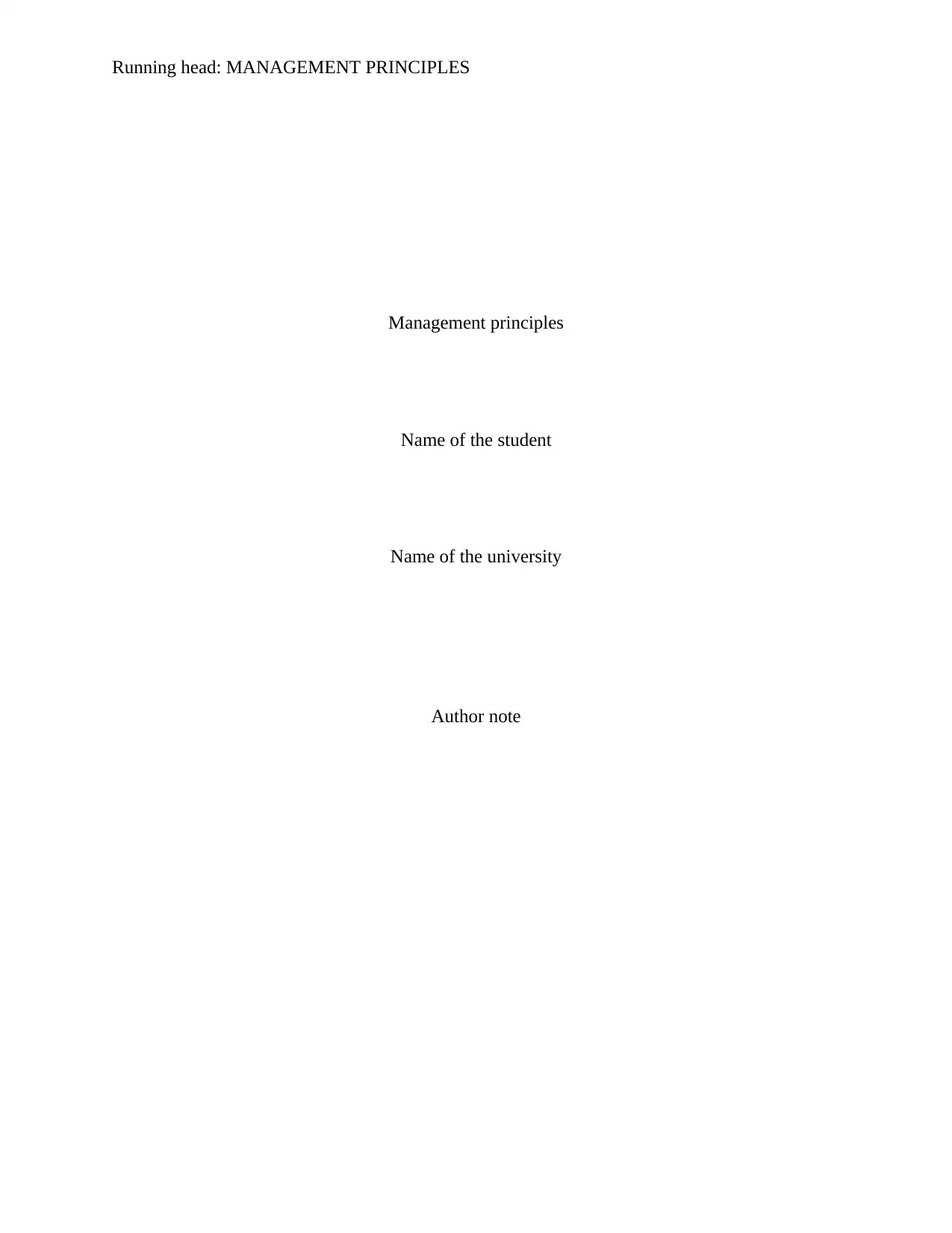
Running head: MANAGEMENT PRINCIPLES
Management principles
Name of the student
Name of the university
Author note
Management principles
Name of the student
Name of the university
Author note
Secure Best Marks with AI Grader
Need help grading? Try our AI Grader for instant feedback on your assignments.
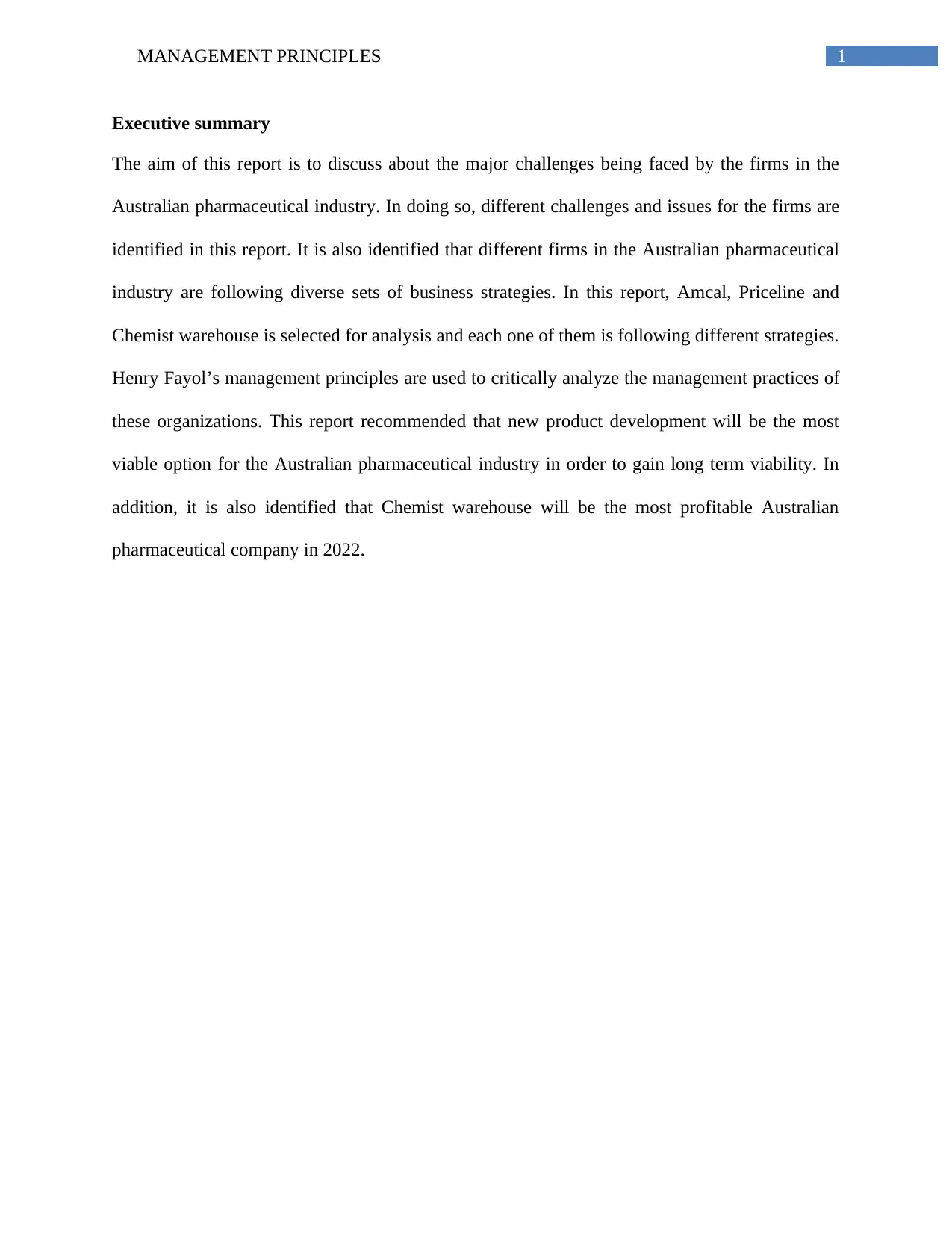
1MANAGEMENT PRINCIPLES
Executive summary
The aim of this report is to discuss about the major challenges being faced by the firms in the
Australian pharmaceutical industry. In doing so, different challenges and issues for the firms are
identified in this report. It is also identified that different firms in the Australian pharmaceutical
industry are following diverse sets of business strategies. In this report, Amcal, Priceline and
Chemist warehouse is selected for analysis and each one of them is following different strategies.
Henry Fayol’s management principles are used to critically analyze the management practices of
these organizations. This report recommended that new product development will be the most
viable option for the Australian pharmaceutical industry in order to gain long term viability. In
addition, it is also identified that Chemist warehouse will be the most profitable Australian
pharmaceutical company in 2022.
Executive summary
The aim of this report is to discuss about the major challenges being faced by the firms in the
Australian pharmaceutical industry. In doing so, different challenges and issues for the firms are
identified in this report. It is also identified that different firms in the Australian pharmaceutical
industry are following diverse sets of business strategies. In this report, Amcal, Priceline and
Chemist warehouse is selected for analysis and each one of them is following different strategies.
Henry Fayol’s management principles are used to critically analyze the management practices of
these organizations. This report recommended that new product development will be the most
viable option for the Australian pharmaceutical industry in order to gain long term viability. In
addition, it is also identified that Chemist warehouse will be the most profitable Australian
pharmaceutical company in 2022.
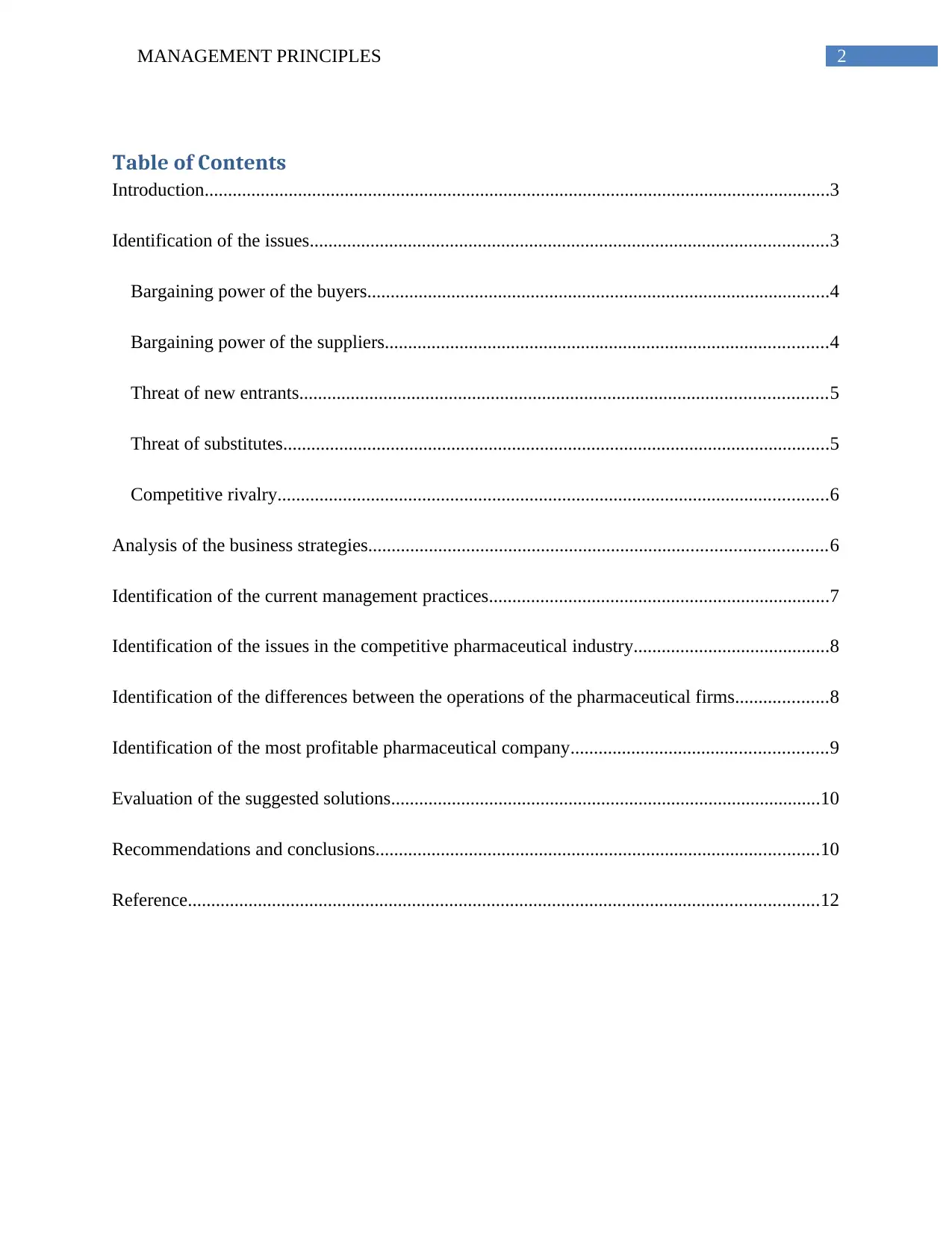
2MANAGEMENT PRINCIPLES
Table of Contents
Introduction......................................................................................................................................3
Identification of the issues...............................................................................................................3
Bargaining power of the buyers...................................................................................................4
Bargaining power of the suppliers...............................................................................................4
Threat of new entrants.................................................................................................................5
Threat of substitutes.....................................................................................................................5
Competitive rivalry......................................................................................................................6
Analysis of the business strategies..................................................................................................6
Identification of the current management practices.........................................................................7
Identification of the issues in the competitive pharmaceutical industry..........................................8
Identification of the differences between the operations of the pharmaceutical firms....................8
Identification of the most profitable pharmaceutical company.......................................................9
Evaluation of the suggested solutions............................................................................................10
Recommendations and conclusions...............................................................................................10
Reference.......................................................................................................................................12
Table of Contents
Introduction......................................................................................................................................3
Identification of the issues...............................................................................................................3
Bargaining power of the buyers...................................................................................................4
Bargaining power of the suppliers...............................................................................................4
Threat of new entrants.................................................................................................................5
Threat of substitutes.....................................................................................................................5
Competitive rivalry......................................................................................................................6
Analysis of the business strategies..................................................................................................6
Identification of the current management practices.........................................................................7
Identification of the issues in the competitive pharmaceutical industry..........................................8
Identification of the differences between the operations of the pharmaceutical firms....................8
Identification of the most profitable pharmaceutical company.......................................................9
Evaluation of the suggested solutions............................................................................................10
Recommendations and conclusions...............................................................................................10
Reference.......................................................................................................................................12
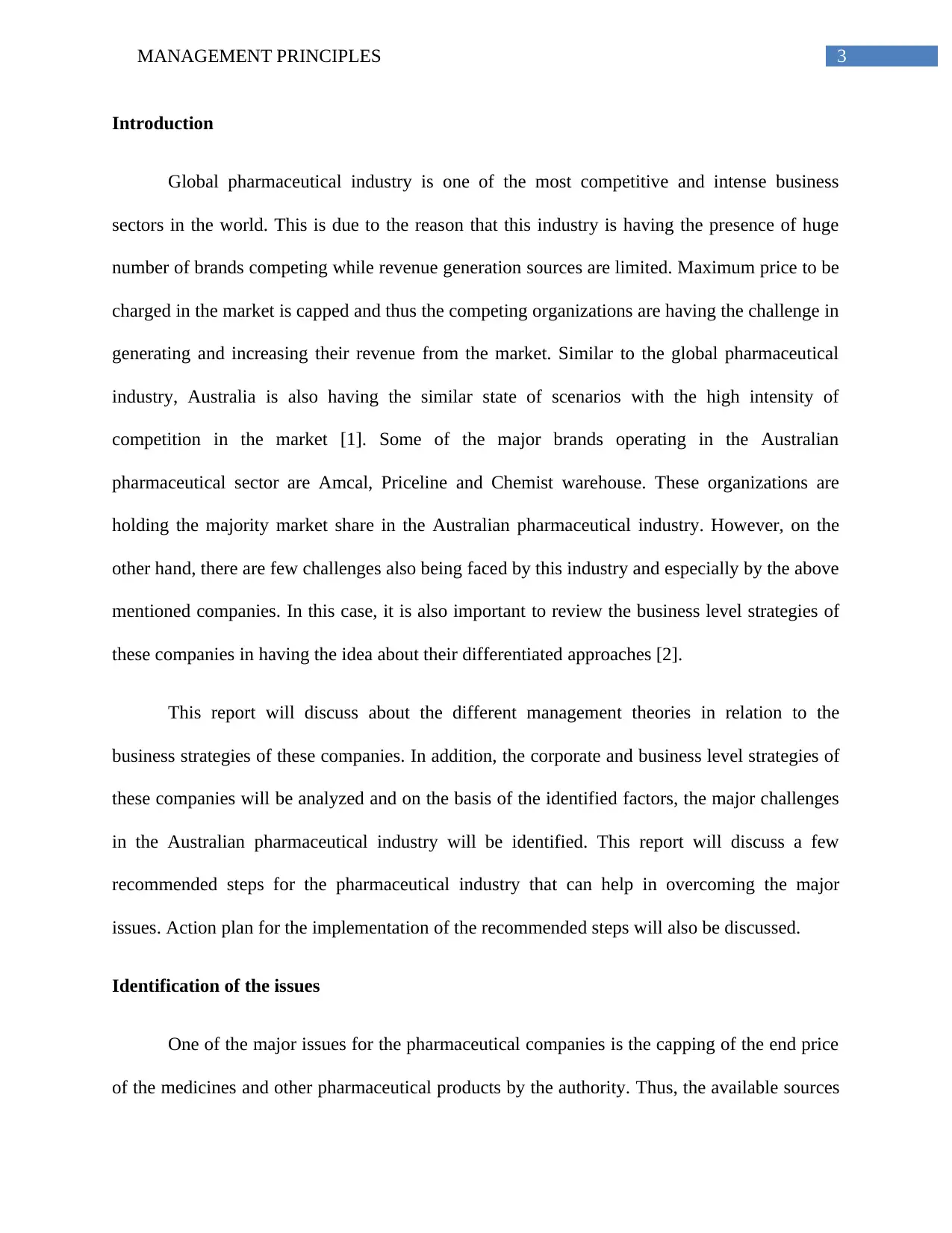
3MANAGEMENT PRINCIPLES
Introduction
Global pharmaceutical industry is one of the most competitive and intense business
sectors in the world. This is due to the reason that this industry is having the presence of huge
number of brands competing while revenue generation sources are limited. Maximum price to be
charged in the market is capped and thus the competing organizations are having the challenge in
generating and increasing their revenue from the market. Similar to the global pharmaceutical
industry, Australia is also having the similar state of scenarios with the high intensity of
competition in the market [1]. Some of the major brands operating in the Australian
pharmaceutical sector are Amcal, Priceline and Chemist warehouse. These organizations are
holding the majority market share in the Australian pharmaceutical industry. However, on the
other hand, there are few challenges also being faced by this industry and especially by the above
mentioned companies. In this case, it is also important to review the business level strategies of
these companies in having the idea about their differentiated approaches [2].
This report will discuss about the different management theories in relation to the
business strategies of these companies. In addition, the corporate and business level strategies of
these companies will be analyzed and on the basis of the identified factors, the major challenges
in the Australian pharmaceutical industry will be identified. This report will discuss a few
recommended steps for the pharmaceutical industry that can help in overcoming the major
issues. Action plan for the implementation of the recommended steps will also be discussed.
Identification of the issues
One of the major issues for the pharmaceutical companies is the capping of the end price
of the medicines and other pharmaceutical products by the authority. Thus, the available sources
Introduction
Global pharmaceutical industry is one of the most competitive and intense business
sectors in the world. This is due to the reason that this industry is having the presence of huge
number of brands competing while revenue generation sources are limited. Maximum price to be
charged in the market is capped and thus the competing organizations are having the challenge in
generating and increasing their revenue from the market. Similar to the global pharmaceutical
industry, Australia is also having the similar state of scenarios with the high intensity of
competition in the market [1]. Some of the major brands operating in the Australian
pharmaceutical sector are Amcal, Priceline and Chemist warehouse. These organizations are
holding the majority market share in the Australian pharmaceutical industry. However, on the
other hand, there are few challenges also being faced by this industry and especially by the above
mentioned companies. In this case, it is also important to review the business level strategies of
these companies in having the idea about their differentiated approaches [2].
This report will discuss about the different management theories in relation to the
business strategies of these companies. In addition, the corporate and business level strategies of
these companies will be analyzed and on the basis of the identified factors, the major challenges
in the Australian pharmaceutical industry will be identified. This report will discuss a few
recommended steps for the pharmaceutical industry that can help in overcoming the major
issues. Action plan for the implementation of the recommended steps will also be discussed.
Identification of the issues
One of the major issues for the pharmaceutical companies is the capping of the end price
of the medicines and other pharmaceutical products by the authority. Thus, the available sources
Secure Best Marks with AI Grader
Need help grading? Try our AI Grader for instant feedback on your assignments.
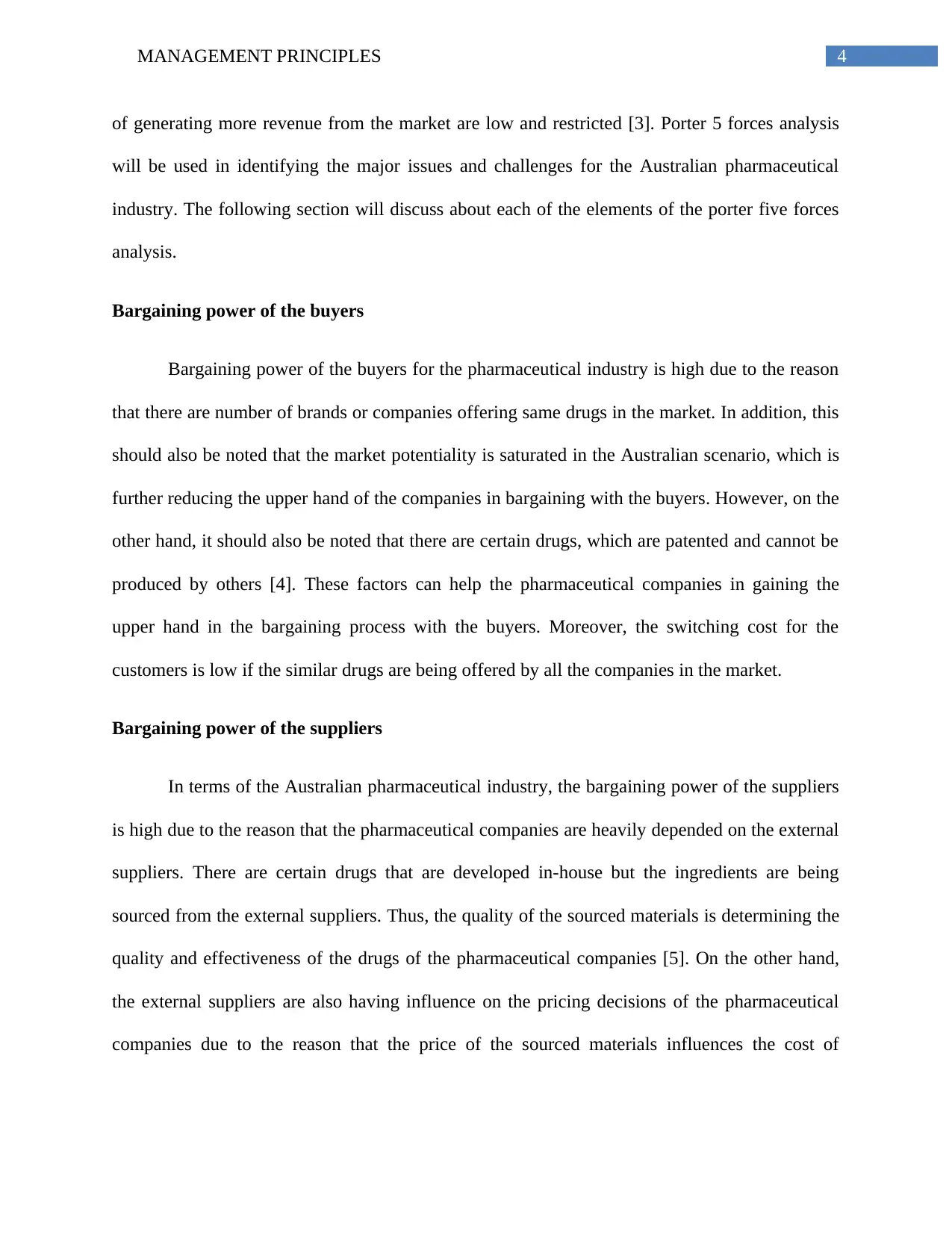
4MANAGEMENT PRINCIPLES
of generating more revenue from the market are low and restricted [3]. Porter 5 forces analysis
will be used in identifying the major issues and challenges for the Australian pharmaceutical
industry. The following section will discuss about each of the elements of the porter five forces
analysis.
Bargaining power of the buyers
Bargaining power of the buyers for the pharmaceutical industry is high due to the reason
that there are number of brands or companies offering same drugs in the market. In addition, this
should also be noted that the market potentiality is saturated in the Australian scenario, which is
further reducing the upper hand of the companies in bargaining with the buyers. However, on the
other hand, it should also be noted that there are certain drugs, which are patented and cannot be
produced by others [4]. These factors can help the pharmaceutical companies in gaining the
upper hand in the bargaining process with the buyers. Moreover, the switching cost for the
customers is low if the similar drugs are being offered by all the companies in the market.
Bargaining power of the suppliers
In terms of the Australian pharmaceutical industry, the bargaining power of the suppliers
is high due to the reason that the pharmaceutical companies are heavily depended on the external
suppliers. There are certain drugs that are developed in-house but the ingredients are being
sourced from the external suppliers. Thus, the quality of the sourced materials is determining the
quality and effectiveness of the drugs of the pharmaceutical companies [5]. On the other hand,
the external suppliers are also having influence on the pricing decisions of the pharmaceutical
companies due to the reason that the price of the sourced materials influences the cost of
of generating more revenue from the market are low and restricted [3]. Porter 5 forces analysis
will be used in identifying the major issues and challenges for the Australian pharmaceutical
industry. The following section will discuss about each of the elements of the porter five forces
analysis.
Bargaining power of the buyers
Bargaining power of the buyers for the pharmaceutical industry is high due to the reason
that there are number of brands or companies offering same drugs in the market. In addition, this
should also be noted that the market potentiality is saturated in the Australian scenario, which is
further reducing the upper hand of the companies in bargaining with the buyers. However, on the
other hand, it should also be noted that there are certain drugs, which are patented and cannot be
produced by others [4]. These factors can help the pharmaceutical companies in gaining the
upper hand in the bargaining process with the buyers. Moreover, the switching cost for the
customers is low if the similar drugs are being offered by all the companies in the market.
Bargaining power of the suppliers
In terms of the Australian pharmaceutical industry, the bargaining power of the suppliers
is high due to the reason that the pharmaceutical companies are heavily depended on the external
suppliers. There are certain drugs that are developed in-house but the ingredients are being
sourced from the external suppliers. Thus, the quality of the sourced materials is determining the
quality and effectiveness of the drugs of the pharmaceutical companies [5]. On the other hand,
the external suppliers are also having influence on the pricing decisions of the pharmaceutical
companies due to the reason that the price of the sourced materials influences the cost of
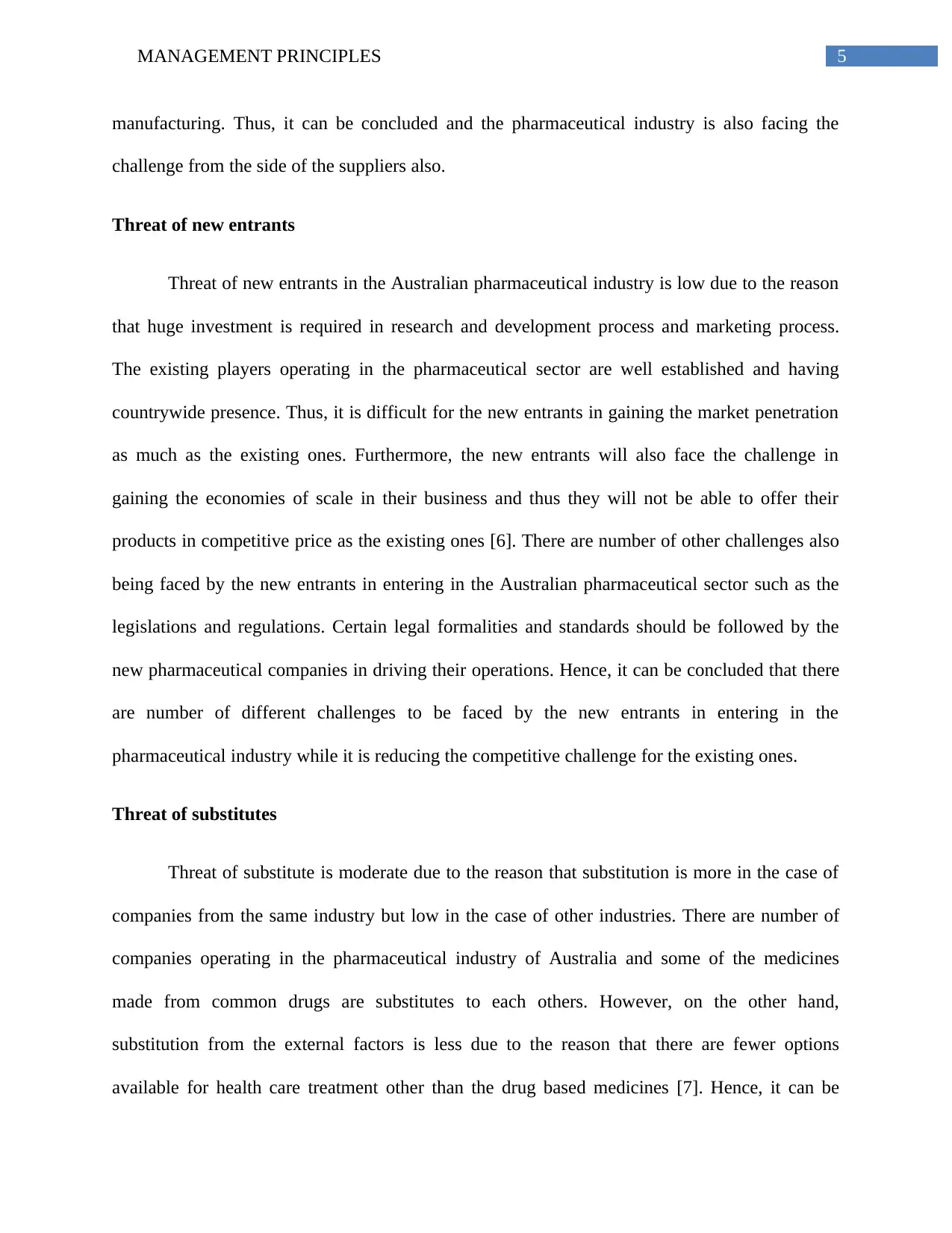
5MANAGEMENT PRINCIPLES
manufacturing. Thus, it can be concluded and the pharmaceutical industry is also facing the
challenge from the side of the suppliers also.
Threat of new entrants
Threat of new entrants in the Australian pharmaceutical industry is low due to the reason
that huge investment is required in research and development process and marketing process.
The existing players operating in the pharmaceutical sector are well established and having
countrywide presence. Thus, it is difficult for the new entrants in gaining the market penetration
as much as the existing ones. Furthermore, the new entrants will also face the challenge in
gaining the economies of scale in their business and thus they will not be able to offer their
products in competitive price as the existing ones [6]. There are number of other challenges also
being faced by the new entrants in entering in the Australian pharmaceutical sector such as the
legislations and regulations. Certain legal formalities and standards should be followed by the
new pharmaceutical companies in driving their operations. Hence, it can be concluded that there
are number of different challenges to be faced by the new entrants in entering in the
pharmaceutical industry while it is reducing the competitive challenge for the existing ones.
Threat of substitutes
Threat of substitute is moderate due to the reason that substitution is more in the case of
companies from the same industry but low in the case of other industries. There are number of
companies operating in the pharmaceutical industry of Australia and some of the medicines
made from common drugs are substitutes to each others. However, on the other hand,
substitution from the external factors is less due to the reason that there are fewer options
available for health care treatment other than the drug based medicines [7]. Hence, it can be
manufacturing. Thus, it can be concluded and the pharmaceutical industry is also facing the
challenge from the side of the suppliers also.
Threat of new entrants
Threat of new entrants in the Australian pharmaceutical industry is low due to the reason
that huge investment is required in research and development process and marketing process.
The existing players operating in the pharmaceutical sector are well established and having
countrywide presence. Thus, it is difficult for the new entrants in gaining the market penetration
as much as the existing ones. Furthermore, the new entrants will also face the challenge in
gaining the economies of scale in their business and thus they will not be able to offer their
products in competitive price as the existing ones [6]. There are number of other challenges also
being faced by the new entrants in entering in the Australian pharmaceutical sector such as the
legislations and regulations. Certain legal formalities and standards should be followed by the
new pharmaceutical companies in driving their operations. Hence, it can be concluded that there
are number of different challenges to be faced by the new entrants in entering in the
pharmaceutical industry while it is reducing the competitive challenge for the existing ones.
Threat of substitutes
Threat of substitute is moderate due to the reason that substitution is more in the case of
companies from the same industry but low in the case of other industries. There are number of
companies operating in the pharmaceutical industry of Australia and some of the medicines
made from common drugs are substitutes to each others. However, on the other hand,
substitution from the external factors is less due to the reason that there are fewer options
available for health care treatment other than the drug based medicines [7]. Hence, it can be
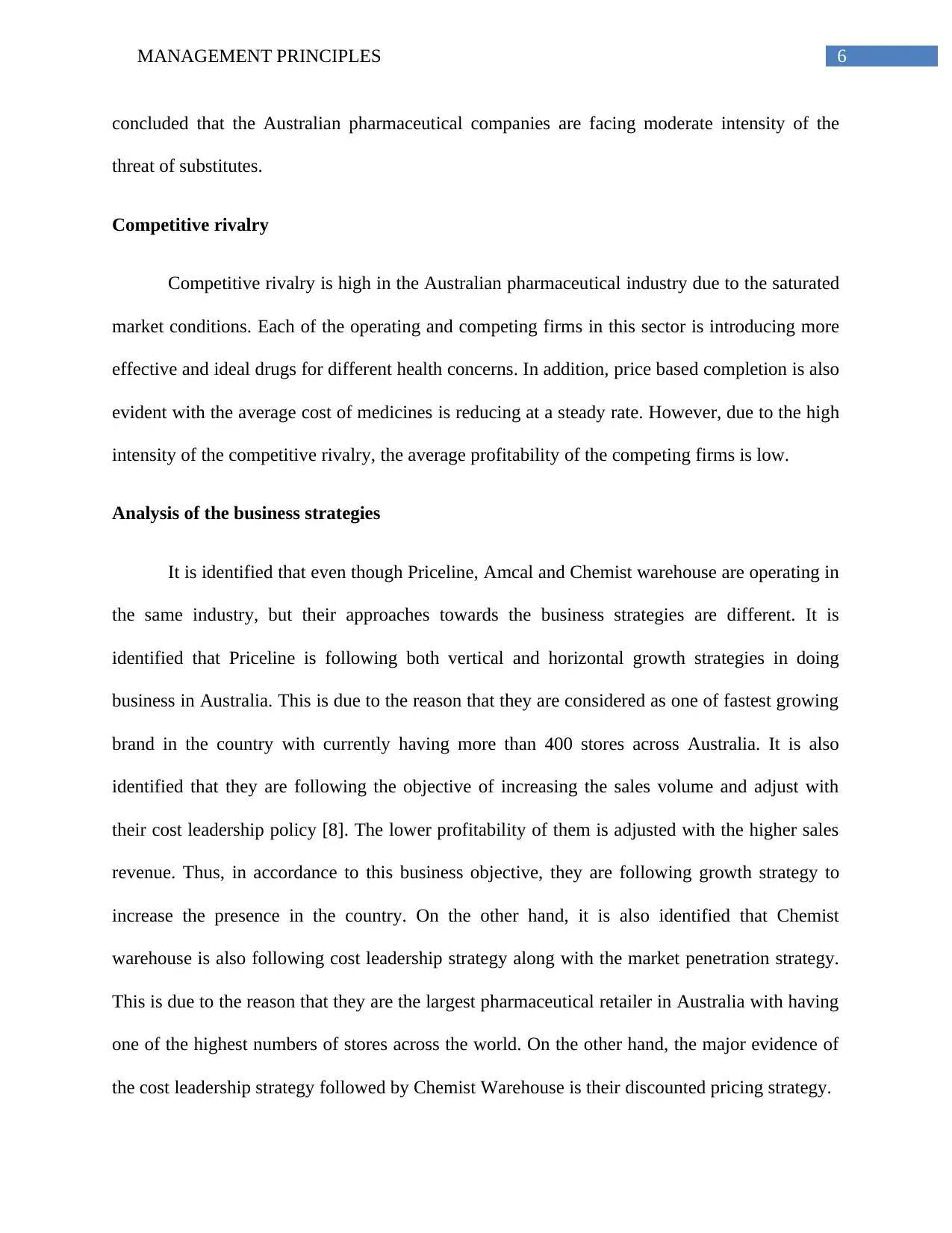
6MANAGEMENT PRINCIPLES
concluded that the Australian pharmaceutical companies are facing moderate intensity of the
threat of substitutes.
Competitive rivalry
Competitive rivalry is high in the Australian pharmaceutical industry due to the saturated
market conditions. Each of the operating and competing firms in this sector is introducing more
effective and ideal drugs for different health concerns. In addition, price based completion is also
evident with the average cost of medicines is reducing at a steady rate. However, due to the high
intensity of the competitive rivalry, the average profitability of the competing firms is low.
Analysis of the business strategies
It is identified that even though Priceline, Amcal and Chemist warehouse are operating in
the same industry, but their approaches towards the business strategies are different. It is
identified that Priceline is following both vertical and horizontal growth strategies in doing
business in Australia. This is due to the reason that they are considered as one of fastest growing
brand in the country with currently having more than 400 stores across Australia. It is also
identified that they are following the objective of increasing the sales volume and adjust with
their cost leadership policy [8]. The lower profitability of them is adjusted with the higher sales
revenue. Thus, in accordance to this business objective, they are following growth strategy to
increase the presence in the country. On the other hand, it is also identified that Chemist
warehouse is also following cost leadership strategy along with the market penetration strategy.
This is due to the reason that they are the largest pharmaceutical retailer in Australia with having
one of the highest numbers of stores across the world. On the other hand, the major evidence of
the cost leadership strategy followed by Chemist Warehouse is their discounted pricing strategy.
concluded that the Australian pharmaceutical companies are facing moderate intensity of the
threat of substitutes.
Competitive rivalry
Competitive rivalry is high in the Australian pharmaceutical industry due to the saturated
market conditions. Each of the operating and competing firms in this sector is introducing more
effective and ideal drugs for different health concerns. In addition, price based completion is also
evident with the average cost of medicines is reducing at a steady rate. However, due to the high
intensity of the competitive rivalry, the average profitability of the competing firms is low.
Analysis of the business strategies
It is identified that even though Priceline, Amcal and Chemist warehouse are operating in
the same industry, but their approaches towards the business strategies are different. It is
identified that Priceline is following both vertical and horizontal growth strategies in doing
business in Australia. This is due to the reason that they are considered as one of fastest growing
brand in the country with currently having more than 400 stores across Australia. It is also
identified that they are following the objective of increasing the sales volume and adjust with
their cost leadership policy [8]. The lower profitability of them is adjusted with the higher sales
revenue. Thus, in accordance to this business objective, they are following growth strategy to
increase the presence in the country. On the other hand, it is also identified that Chemist
warehouse is also following cost leadership strategy along with the market penetration strategy.
This is due to the reason that they are the largest pharmaceutical retailer in Australia with having
one of the highest numbers of stores across the world. On the other hand, the major evidence of
the cost leadership strategy followed by Chemist Warehouse is their discounted pricing strategy.
Paraphrase This Document
Need a fresh take? Get an instant paraphrase of this document with our AI Paraphraser
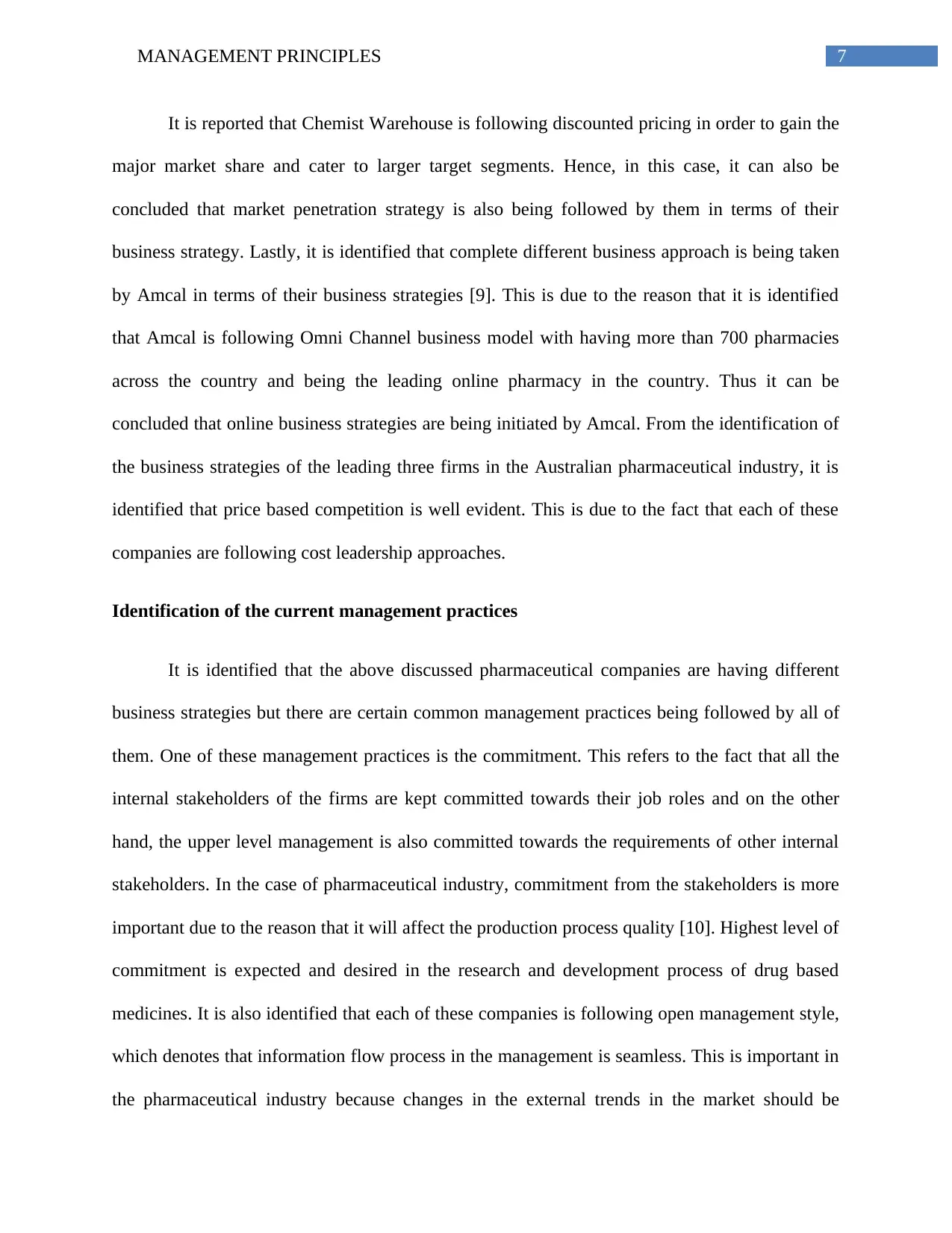
7MANAGEMENT PRINCIPLES
It is reported that Chemist Warehouse is following discounted pricing in order to gain the
major market share and cater to larger target segments. Hence, in this case, it can also be
concluded that market penetration strategy is also being followed by them in terms of their
business strategy. Lastly, it is identified that complete different business approach is being taken
by Amcal in terms of their business strategies [9]. This is due to the reason that it is identified
that Amcal is following Omni Channel business model with having more than 700 pharmacies
across the country and being the leading online pharmacy in the country. Thus it can be
concluded that online business strategies are being initiated by Amcal. From the identification of
the business strategies of the leading three firms in the Australian pharmaceutical industry, it is
identified that price based competition is well evident. This is due to the fact that each of these
companies are following cost leadership approaches.
Identification of the current management practices
It is identified that the above discussed pharmaceutical companies are having different
business strategies but there are certain common management practices being followed by all of
them. One of these management practices is the commitment. This refers to the fact that all the
internal stakeholders of the firms are kept committed towards their job roles and on the other
hand, the upper level management is also committed towards the requirements of other internal
stakeholders. In the case of pharmaceutical industry, commitment from the stakeholders is more
important due to the reason that it will affect the production process quality [10]. Highest level of
commitment is expected and desired in the research and development process of drug based
medicines. It is also identified that each of these companies is following open management style,
which denotes that information flow process in the management is seamless. This is important in
the pharmaceutical industry because changes in the external trends in the market should be
It is reported that Chemist Warehouse is following discounted pricing in order to gain the
major market share and cater to larger target segments. Hence, in this case, it can also be
concluded that market penetration strategy is also being followed by them in terms of their
business strategy. Lastly, it is identified that complete different business approach is being taken
by Amcal in terms of their business strategies [9]. This is due to the reason that it is identified
that Amcal is following Omni Channel business model with having more than 700 pharmacies
across the country and being the leading online pharmacy in the country. Thus it can be
concluded that online business strategies are being initiated by Amcal. From the identification of
the business strategies of the leading three firms in the Australian pharmaceutical industry, it is
identified that price based competition is well evident. This is due to the fact that each of these
companies are following cost leadership approaches.
Identification of the current management practices
It is identified that the above discussed pharmaceutical companies are having different
business strategies but there are certain common management practices being followed by all of
them. One of these management practices is the commitment. This refers to the fact that all the
internal stakeholders of the firms are kept committed towards their job roles and on the other
hand, the upper level management is also committed towards the requirements of other internal
stakeholders. In the case of pharmaceutical industry, commitment from the stakeholders is more
important due to the reason that it will affect the production process quality [10]. Highest level of
commitment is expected and desired in the research and development process of drug based
medicines. It is also identified that each of these companies is following open management style,
which denotes that information flow process in the management is seamless. This is important in
the pharmaceutical industry because changes in the external trends in the market should be
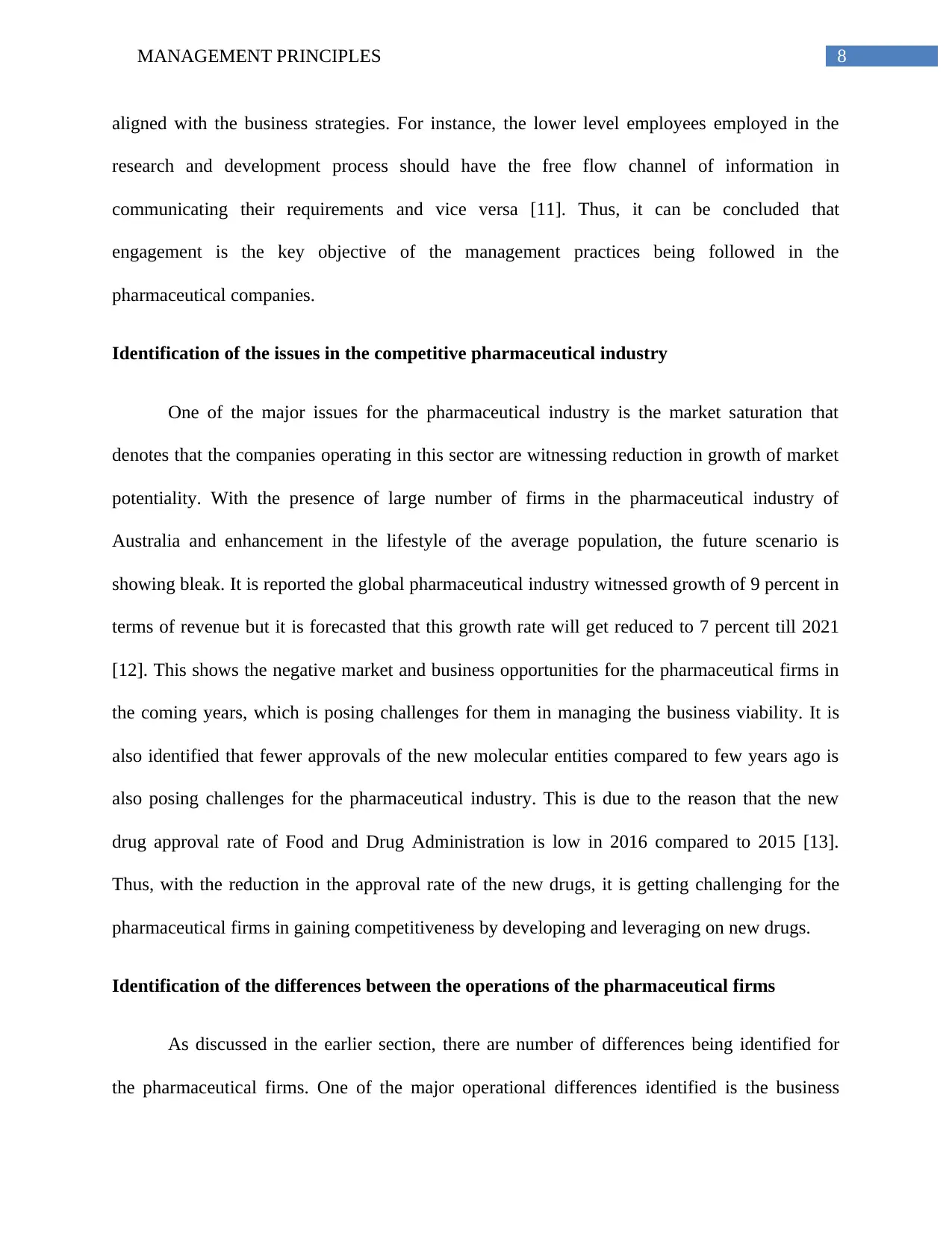
8MANAGEMENT PRINCIPLES
aligned with the business strategies. For instance, the lower level employees employed in the
research and development process should have the free flow channel of information in
communicating their requirements and vice versa [11]. Thus, it can be concluded that
engagement is the key objective of the management practices being followed in the
pharmaceutical companies.
Identification of the issues in the competitive pharmaceutical industry
One of the major issues for the pharmaceutical industry is the market saturation that
denotes that the companies operating in this sector are witnessing reduction in growth of market
potentiality. With the presence of large number of firms in the pharmaceutical industry of
Australia and enhancement in the lifestyle of the average population, the future scenario is
showing bleak. It is reported the global pharmaceutical industry witnessed growth of 9 percent in
terms of revenue but it is forecasted that this growth rate will get reduced to 7 percent till 2021
[12]. This shows the negative market and business opportunities for the pharmaceutical firms in
the coming years, which is posing challenges for them in managing the business viability. It is
also identified that fewer approvals of the new molecular entities compared to few years ago is
also posing challenges for the pharmaceutical industry. This is due to the reason that the new
drug approval rate of Food and Drug Administration is low in 2016 compared to 2015 [13].
Thus, with the reduction in the approval rate of the new drugs, it is getting challenging for the
pharmaceutical firms in gaining competitiveness by developing and leveraging on new drugs.
Identification of the differences between the operations of the pharmaceutical firms
As discussed in the earlier section, there are number of differences being identified for
the pharmaceutical firms. One of the major operational differences identified is the business
aligned with the business strategies. For instance, the lower level employees employed in the
research and development process should have the free flow channel of information in
communicating their requirements and vice versa [11]. Thus, it can be concluded that
engagement is the key objective of the management practices being followed in the
pharmaceutical companies.
Identification of the issues in the competitive pharmaceutical industry
One of the major issues for the pharmaceutical industry is the market saturation that
denotes that the companies operating in this sector are witnessing reduction in growth of market
potentiality. With the presence of large number of firms in the pharmaceutical industry of
Australia and enhancement in the lifestyle of the average population, the future scenario is
showing bleak. It is reported the global pharmaceutical industry witnessed growth of 9 percent in
terms of revenue but it is forecasted that this growth rate will get reduced to 7 percent till 2021
[12]. This shows the negative market and business opportunities for the pharmaceutical firms in
the coming years, which is posing challenges for them in managing the business viability. It is
also identified that fewer approvals of the new molecular entities compared to few years ago is
also posing challenges for the pharmaceutical industry. This is due to the reason that the new
drug approval rate of Food and Drug Administration is low in 2016 compared to 2015 [13].
Thus, with the reduction in the approval rate of the new drugs, it is getting challenging for the
pharmaceutical firms in gaining competitiveness by developing and leveraging on new drugs.
Identification of the differences between the operations of the pharmaceutical firms
As discussed in the earlier section, there are number of differences being identified for
the pharmaceutical firms. One of the major operational differences identified is the business
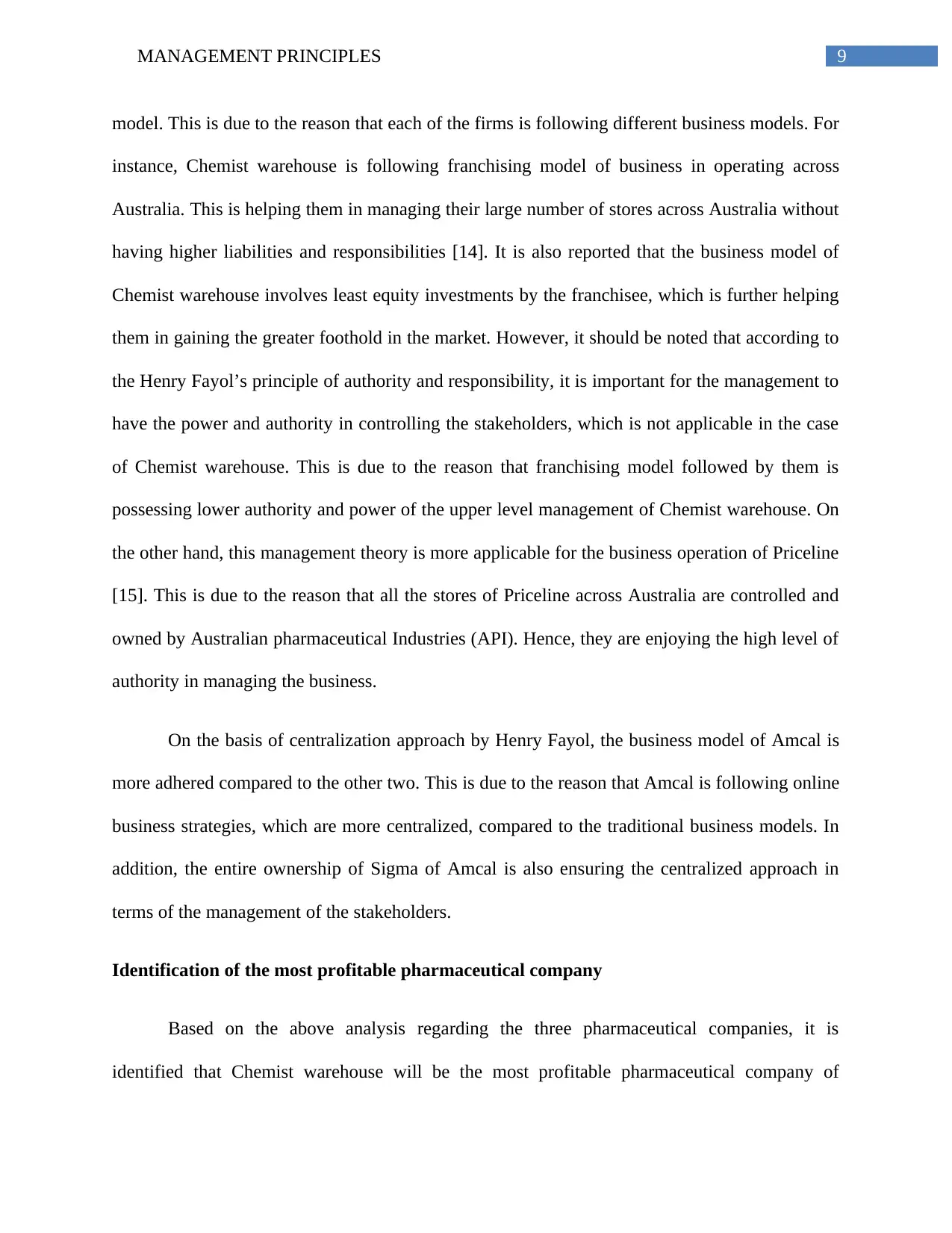
9MANAGEMENT PRINCIPLES
model. This is due to the reason that each of the firms is following different business models. For
instance, Chemist warehouse is following franchising model of business in operating across
Australia. This is helping them in managing their large number of stores across Australia without
having higher liabilities and responsibilities [14]. It is also reported that the business model of
Chemist warehouse involves least equity investments by the franchisee, which is further helping
them in gaining the greater foothold in the market. However, it should be noted that according to
the Henry Fayol’s principle of authority and responsibility, it is important for the management to
have the power and authority in controlling the stakeholders, which is not applicable in the case
of Chemist warehouse. This is due to the reason that franchising model followed by them is
possessing lower authority and power of the upper level management of Chemist warehouse. On
the other hand, this management theory is more applicable for the business operation of Priceline
[15]. This is due to the reason that all the stores of Priceline across Australia are controlled and
owned by Australian pharmaceutical Industries (API). Hence, they are enjoying the high level of
authority in managing the business.
On the basis of centralization approach by Henry Fayol, the business model of Amcal is
more adhered compared to the other two. This is due to the reason that Amcal is following online
business strategies, which are more centralized, compared to the traditional business models. In
addition, the entire ownership of Sigma of Amcal is also ensuring the centralized approach in
terms of the management of the stakeholders.
Identification of the most profitable pharmaceutical company
Based on the above analysis regarding the three pharmaceutical companies, it is
identified that Chemist warehouse will be the most profitable pharmaceutical company of
model. This is due to the reason that each of the firms is following different business models. For
instance, Chemist warehouse is following franchising model of business in operating across
Australia. This is helping them in managing their large number of stores across Australia without
having higher liabilities and responsibilities [14]. It is also reported that the business model of
Chemist warehouse involves least equity investments by the franchisee, which is further helping
them in gaining the greater foothold in the market. However, it should be noted that according to
the Henry Fayol’s principle of authority and responsibility, it is important for the management to
have the power and authority in controlling the stakeholders, which is not applicable in the case
of Chemist warehouse. This is due to the reason that franchising model followed by them is
possessing lower authority and power of the upper level management of Chemist warehouse. On
the other hand, this management theory is more applicable for the business operation of Priceline
[15]. This is due to the reason that all the stores of Priceline across Australia are controlled and
owned by Australian pharmaceutical Industries (API). Hence, they are enjoying the high level of
authority in managing the business.
On the basis of centralization approach by Henry Fayol, the business model of Amcal is
more adhered compared to the other two. This is due to the reason that Amcal is following online
business strategies, which are more centralized, compared to the traditional business models. In
addition, the entire ownership of Sigma of Amcal is also ensuring the centralized approach in
terms of the management of the stakeholders.
Identification of the most profitable pharmaceutical company
Based on the above analysis regarding the three pharmaceutical companies, it is
identified that Chemist warehouse will be the most profitable pharmaceutical company of
Secure Best Marks with AI Grader
Need help grading? Try our AI Grader for instant feedback on your assignments.
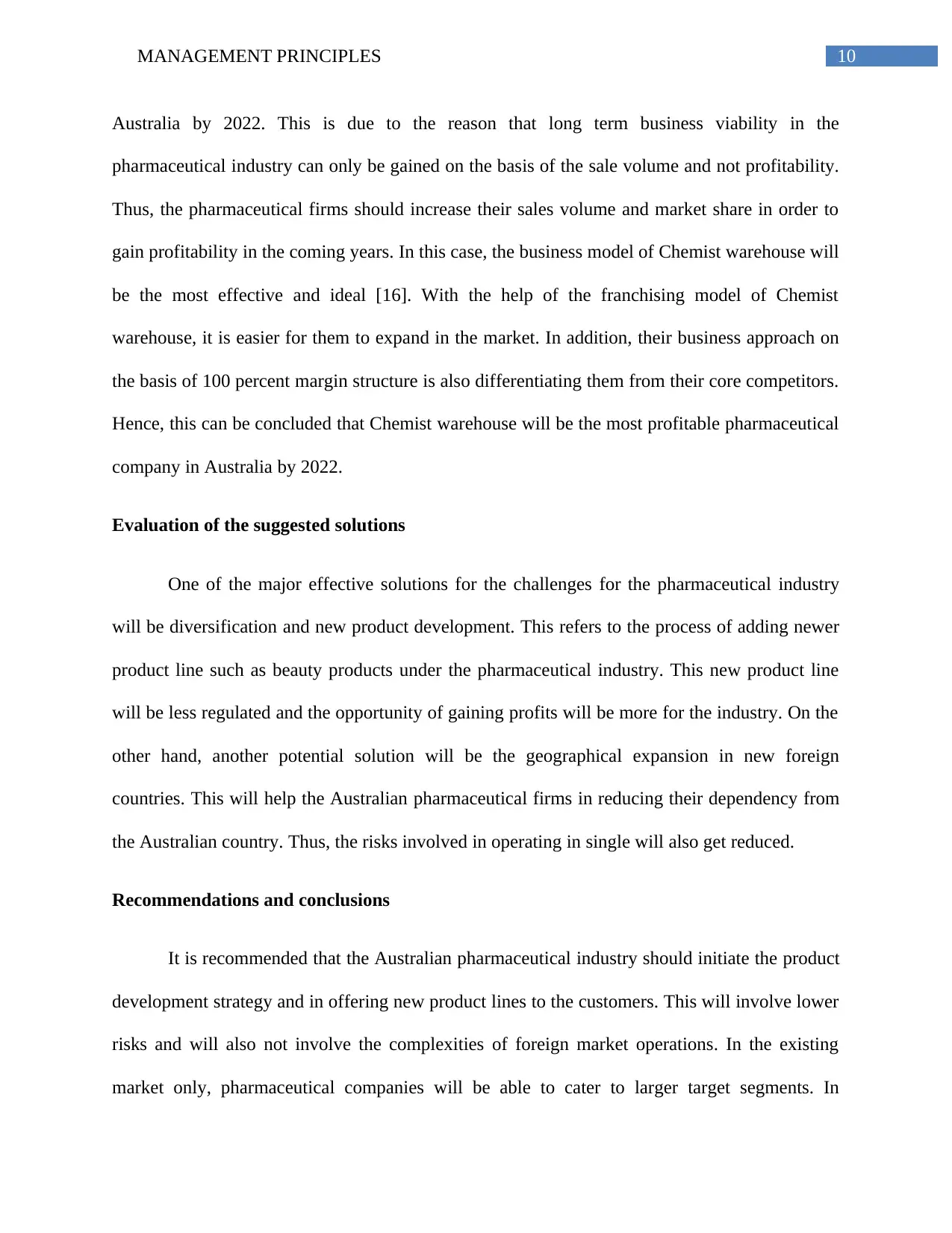
10MANAGEMENT PRINCIPLES
Australia by 2022. This is due to the reason that long term business viability in the
pharmaceutical industry can only be gained on the basis of the sale volume and not profitability.
Thus, the pharmaceutical firms should increase their sales volume and market share in order to
gain profitability in the coming years. In this case, the business model of Chemist warehouse will
be the most effective and ideal [16]. With the help of the franchising model of Chemist
warehouse, it is easier for them to expand in the market. In addition, their business approach on
the basis of 100 percent margin structure is also differentiating them from their core competitors.
Hence, this can be concluded that Chemist warehouse will be the most profitable pharmaceutical
company in Australia by 2022.
Evaluation of the suggested solutions
One of the major effective solutions for the challenges for the pharmaceutical industry
will be diversification and new product development. This refers to the process of adding newer
product line such as beauty products under the pharmaceutical industry. This new product line
will be less regulated and the opportunity of gaining profits will be more for the industry. On the
other hand, another potential solution will be the geographical expansion in new foreign
countries. This will help the Australian pharmaceutical firms in reducing their dependency from
the Australian country. Thus, the risks involved in operating in single will also get reduced.
Recommendations and conclusions
It is recommended that the Australian pharmaceutical industry should initiate the product
development strategy and in offering new product lines to the customers. This will involve lower
risks and will also not involve the complexities of foreign market operations. In the existing
market only, pharmaceutical companies will be able to cater to larger target segments. In
Australia by 2022. This is due to the reason that long term business viability in the
pharmaceutical industry can only be gained on the basis of the sale volume and not profitability.
Thus, the pharmaceutical firms should increase their sales volume and market share in order to
gain profitability in the coming years. In this case, the business model of Chemist warehouse will
be the most effective and ideal [16]. With the help of the franchising model of Chemist
warehouse, it is easier for them to expand in the market. In addition, their business approach on
the basis of 100 percent margin structure is also differentiating them from their core competitors.
Hence, this can be concluded that Chemist warehouse will be the most profitable pharmaceutical
company in Australia by 2022.
Evaluation of the suggested solutions
One of the major effective solutions for the challenges for the pharmaceutical industry
will be diversification and new product development. This refers to the process of adding newer
product line such as beauty products under the pharmaceutical industry. This new product line
will be less regulated and the opportunity of gaining profits will be more for the industry. On the
other hand, another potential solution will be the geographical expansion in new foreign
countries. This will help the Australian pharmaceutical firms in reducing their dependency from
the Australian country. Thus, the risks involved in operating in single will also get reduced.
Recommendations and conclusions
It is recommended that the Australian pharmaceutical industry should initiate the product
development strategy and in offering new product lines to the customers. This will involve lower
risks and will also not involve the complexities of foreign market operations. In the existing
market only, pharmaceutical companies will be able to cater to larger target segments. In
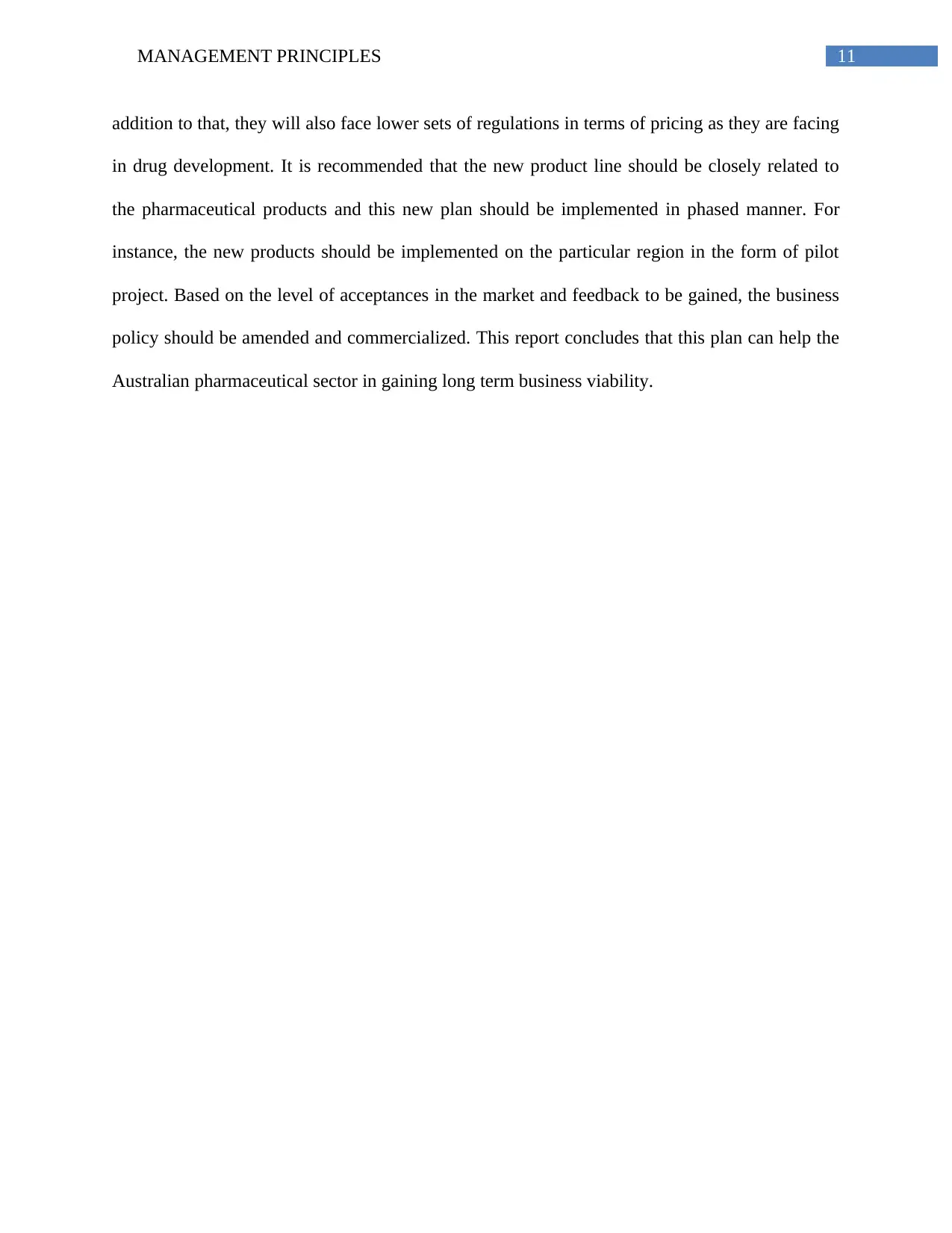
11MANAGEMENT PRINCIPLES
addition to that, they will also face lower sets of regulations in terms of pricing as they are facing
in drug development. It is recommended that the new product line should be closely related to
the pharmaceutical products and this new plan should be implemented in phased manner. For
instance, the new products should be implemented on the particular region in the form of pilot
project. Based on the level of acceptances in the market and feedback to be gained, the business
policy should be amended and commercialized. This report concludes that this plan can help the
Australian pharmaceutical sector in gaining long term business viability.
addition to that, they will also face lower sets of regulations in terms of pricing as they are facing
in drug development. It is recommended that the new product line should be closely related to
the pharmaceutical products and this new plan should be implemented in phased manner. For
instance, the new products should be implemented on the particular region in the form of pilot
project. Based on the level of acceptances in the market and feedback to be gained, the business
policy should be amended and commercialized. This report concludes that this plan can help the
Australian pharmaceutical sector in gaining long term business viability.
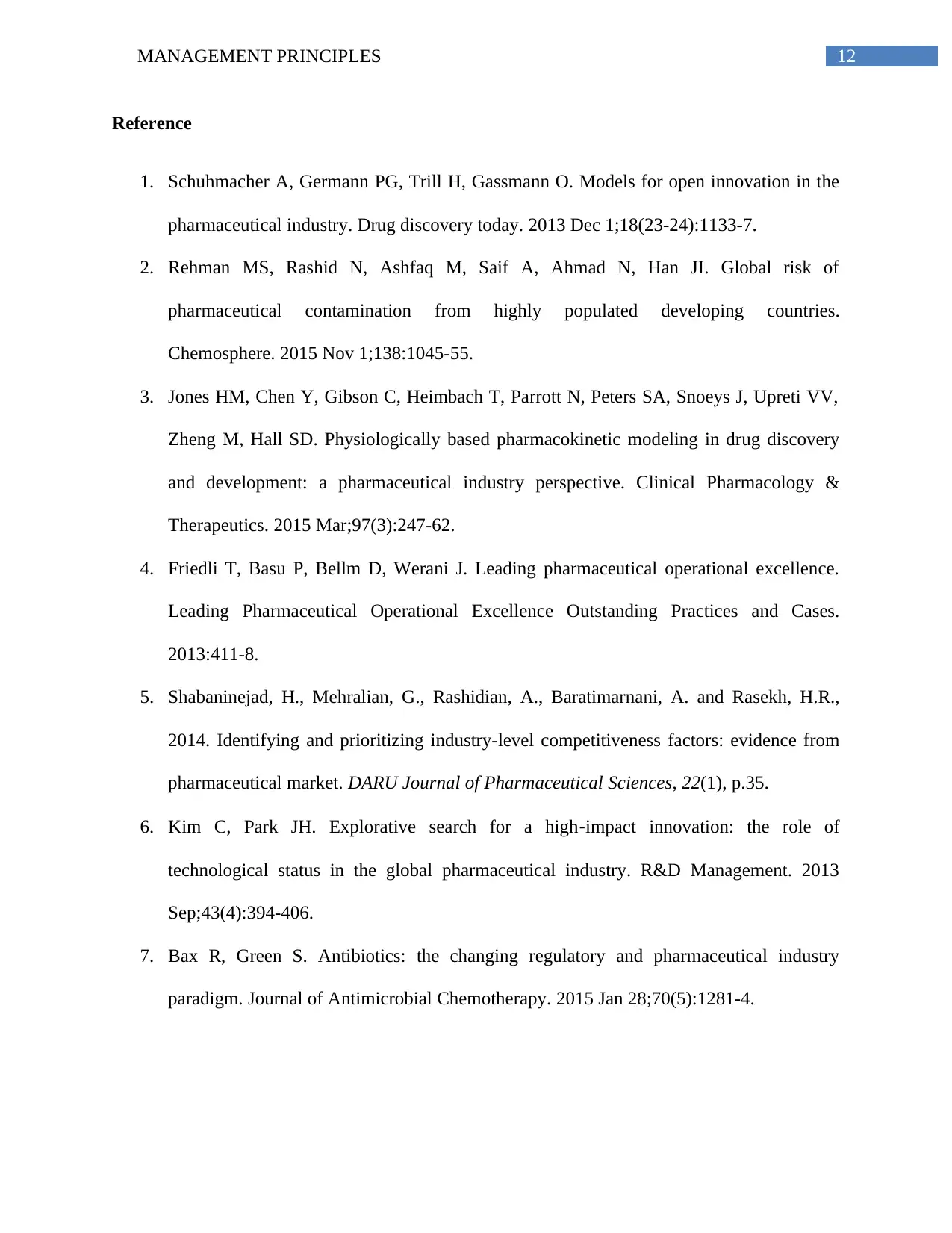
12MANAGEMENT PRINCIPLES
Reference
1. Schuhmacher A, Germann PG, Trill H, Gassmann O. Models for open innovation in the
pharmaceutical industry. Drug discovery today. 2013 Dec 1;18(23-24):1133-7.
2. Rehman MS, Rashid N, Ashfaq M, Saif A, Ahmad N, Han JI. Global risk of
pharmaceutical contamination from highly populated developing countries.
Chemosphere. 2015 Nov 1;138:1045-55.
3. Jones HM, Chen Y, Gibson C, Heimbach T, Parrott N, Peters SA, Snoeys J, Upreti VV,
Zheng M, Hall SD. Physiologically based pharmacokinetic modeling in drug discovery
and development: a pharmaceutical industry perspective. Clinical Pharmacology &
Therapeutics. 2015 Mar;97(3):247-62.
4. Friedli T, Basu P, Bellm D, Werani J. Leading pharmaceutical operational excellence.
Leading Pharmaceutical Operational Excellence Outstanding Practices and Cases.
2013:411-8.
5. Shabaninejad, H., Mehralian, G., Rashidian, A., Baratimarnani, A. and Rasekh, H.R.,
2014. Identifying and prioritizing industry-level competitiveness factors: evidence from
pharmaceutical market. DARU Journal of Pharmaceutical Sciences, 22(1), p.35.
6. Kim C, Park JH. Explorative search for a high‐impact innovation: the role of
technological status in the global pharmaceutical industry. R&D Management. 2013
Sep;43(4):394-406.
7. Bax R, Green S. Antibiotics: the changing regulatory and pharmaceutical industry
paradigm. Journal of Antimicrobial Chemotherapy. 2015 Jan 28;70(5):1281-4.
Reference
1. Schuhmacher A, Germann PG, Trill H, Gassmann O. Models for open innovation in the
pharmaceutical industry. Drug discovery today. 2013 Dec 1;18(23-24):1133-7.
2. Rehman MS, Rashid N, Ashfaq M, Saif A, Ahmad N, Han JI. Global risk of
pharmaceutical contamination from highly populated developing countries.
Chemosphere. 2015 Nov 1;138:1045-55.
3. Jones HM, Chen Y, Gibson C, Heimbach T, Parrott N, Peters SA, Snoeys J, Upreti VV,
Zheng M, Hall SD. Physiologically based pharmacokinetic modeling in drug discovery
and development: a pharmaceutical industry perspective. Clinical Pharmacology &
Therapeutics. 2015 Mar;97(3):247-62.
4. Friedli T, Basu P, Bellm D, Werani J. Leading pharmaceutical operational excellence.
Leading Pharmaceutical Operational Excellence Outstanding Practices and Cases.
2013:411-8.
5. Shabaninejad, H., Mehralian, G., Rashidian, A., Baratimarnani, A. and Rasekh, H.R.,
2014. Identifying and prioritizing industry-level competitiveness factors: evidence from
pharmaceutical market. DARU Journal of Pharmaceutical Sciences, 22(1), p.35.
6. Kim C, Park JH. Explorative search for a high‐impact innovation: the role of
technological status in the global pharmaceutical industry. R&D Management. 2013
Sep;43(4):394-406.
7. Bax R, Green S. Antibiotics: the changing regulatory and pharmaceutical industry
paradigm. Journal of Antimicrobial Chemotherapy. 2015 Jan 28;70(5):1281-4.
Paraphrase This Document
Need a fresh take? Get an instant paraphrase of this document with our AI Paraphraser
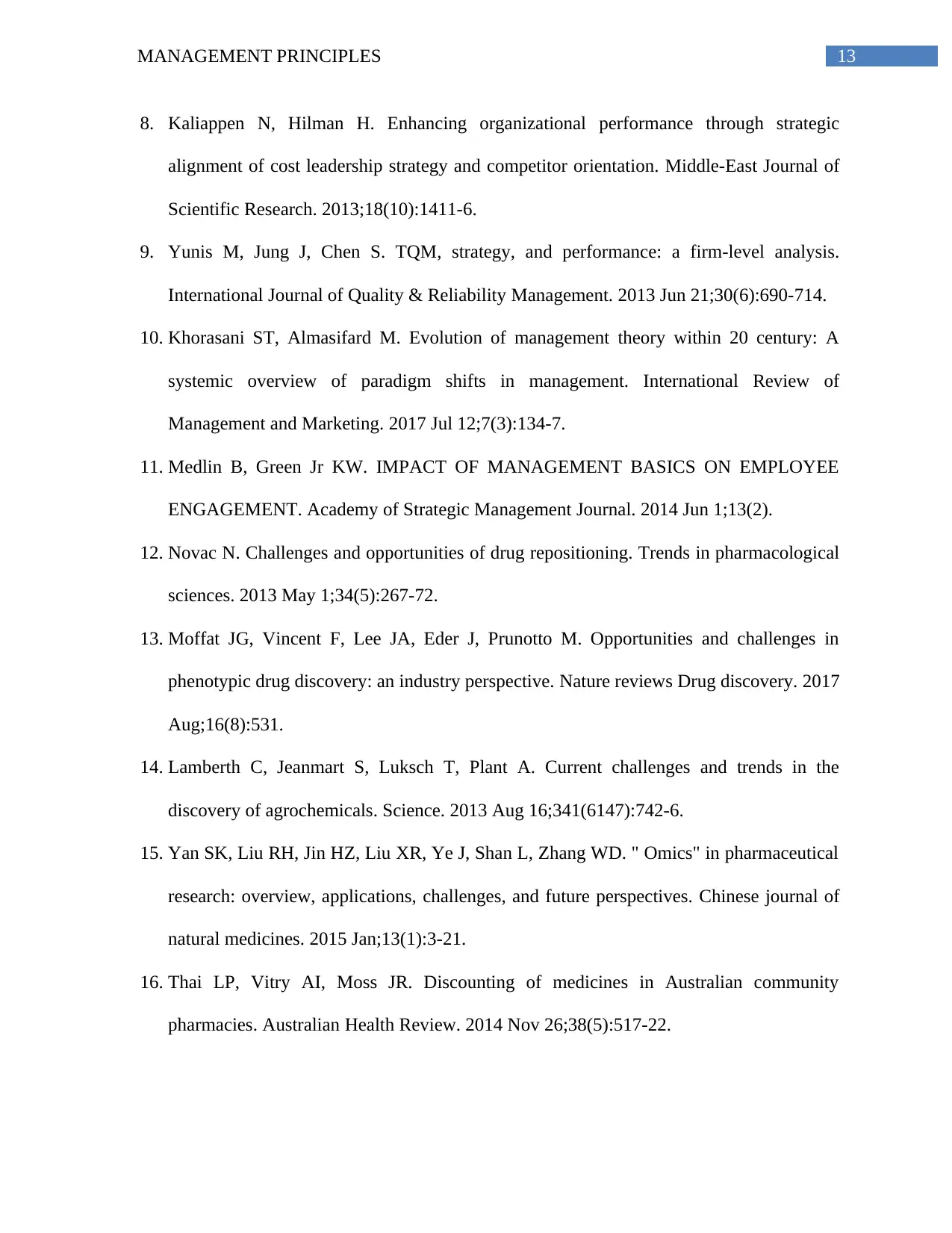
13MANAGEMENT PRINCIPLES
8. Kaliappen N, Hilman H. Enhancing organizational performance through strategic
alignment of cost leadership strategy and competitor orientation. Middle-East Journal of
Scientific Research. 2013;18(10):1411-6.
9. Yunis M, Jung J, Chen S. TQM, strategy, and performance: a firm-level analysis.
International Journal of Quality & Reliability Management. 2013 Jun 21;30(6):690-714.
10. Khorasani ST, Almasifard M. Evolution of management theory within 20 century: A
systemic overview of paradigm shifts in management. International Review of
Management and Marketing. 2017 Jul 12;7(3):134-7.
11. Medlin B, Green Jr KW. IMPACT OF MANAGEMENT BASICS ON EMPLOYEE
ENGAGEMENT. Academy of Strategic Management Journal. 2014 Jun 1;13(2).
12. Novac N. Challenges and opportunities of drug repositioning. Trends in pharmacological
sciences. 2013 May 1;34(5):267-72.
13. Moffat JG, Vincent F, Lee JA, Eder J, Prunotto M. Opportunities and challenges in
phenotypic drug discovery: an industry perspective. Nature reviews Drug discovery. 2017
Aug;16(8):531.
14. Lamberth C, Jeanmart S, Luksch T, Plant A. Current challenges and trends in the
discovery of agrochemicals. Science. 2013 Aug 16;341(6147):742-6.
15. Yan SK, Liu RH, Jin HZ, Liu XR, Ye J, Shan L, Zhang WD. " Omics" in pharmaceutical
research: overview, applications, challenges, and future perspectives. Chinese journal of
natural medicines. 2015 Jan;13(1):3-21.
16. Thai LP, Vitry AI, Moss JR. Discounting of medicines in Australian community
pharmacies. Australian Health Review. 2014 Nov 26;38(5):517-22.
8. Kaliappen N, Hilman H. Enhancing organizational performance through strategic
alignment of cost leadership strategy and competitor orientation. Middle-East Journal of
Scientific Research. 2013;18(10):1411-6.
9. Yunis M, Jung J, Chen S. TQM, strategy, and performance: a firm-level analysis.
International Journal of Quality & Reliability Management. 2013 Jun 21;30(6):690-714.
10. Khorasani ST, Almasifard M. Evolution of management theory within 20 century: A
systemic overview of paradigm shifts in management. International Review of
Management and Marketing. 2017 Jul 12;7(3):134-7.
11. Medlin B, Green Jr KW. IMPACT OF MANAGEMENT BASICS ON EMPLOYEE
ENGAGEMENT. Academy of Strategic Management Journal. 2014 Jun 1;13(2).
12. Novac N. Challenges and opportunities of drug repositioning. Trends in pharmacological
sciences. 2013 May 1;34(5):267-72.
13. Moffat JG, Vincent F, Lee JA, Eder J, Prunotto M. Opportunities and challenges in
phenotypic drug discovery: an industry perspective. Nature reviews Drug discovery. 2017
Aug;16(8):531.
14. Lamberth C, Jeanmart S, Luksch T, Plant A. Current challenges and trends in the
discovery of agrochemicals. Science. 2013 Aug 16;341(6147):742-6.
15. Yan SK, Liu RH, Jin HZ, Liu XR, Ye J, Shan L, Zhang WD. " Omics" in pharmaceutical
research: overview, applications, challenges, and future perspectives. Chinese journal of
natural medicines. 2015 Jan;13(1):3-21.
16. Thai LP, Vitry AI, Moss JR. Discounting of medicines in Australian community
pharmacies. Australian Health Review. 2014 Nov 26;38(5):517-22.
1 out of 14
Related Documents
Your All-in-One AI-Powered Toolkit for Academic Success.
+13062052269
info@desklib.com
Available 24*7 on WhatsApp / Email
![[object Object]](/_next/static/media/star-bottom.7253800d.svg)
Unlock your academic potential
© 2024 | Zucol Services PVT LTD | All rights reserved.





